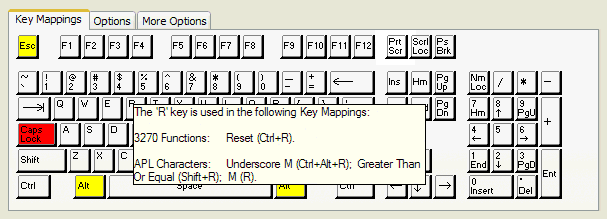Key Mappings tab
Note
If you have installed a non-English version of BlueZone, the default keyboard map that will be displayed is based on your
currently selected language in the Regional and Language Options in Windows.
Gray keys
Gray keys can be mapped. If you place the mouse pointer over a gray key and left click, a light yellow box will appear with
the mappings of that particular key and also any combination key mappings that this key is used in.
The following illustration shows all Key Mappings associated with the R key.
Figure 5: IBM Mainframe keyboard

Red keys
Red keys cannot be used to map 3270 Functions.
Yellow keys
Yellow keys are caution keys. Care should be taken when using the yellow keys to map 3270 Functions. The caution keys include
the Alt keys and the Esc key. Windows uses the Alt keys with menu accelerators and the Esc key is the default BlueZone Full
Screen Hotkey key.
Options
|
|
Keyboard Type: A List Box which contains a list of keyboard options for BlueZone.
Note If you choose either the Unicomp 0852-M 122 Key or the KeyTronic KB3270/Plus keyboard, a 122 Keys... click button will appear
in the upper right hand corner of the dialog. Clicking this button will display a floating keyboard bitmap of the extended
keys.
|
|
|
Functions Group: A List Box which contains a list of a the BlueZone Function Groups that can be mapped.
|
♦ |
3270 Functions: Lists the 3270 functions and what keys they are currently mapped to.
|
|
♦ |
3270 Characters: Lists special 3270 characters like the Cent Sign, Logical Not, and the Solid Vertical Bar and what keys they are currently
mapped to.
|
|
♦ |
Menu Hotkeys: Lists the BlueZone menu items available for key mapping.
|
|
♦ |
PC Data Keys: Lists the PC Keyboard Keys available for key mapping.
|
|
♦ |
APL Characters: Lists APL graphics characters and what they are currently mapped to.
|
|
♦ |
Macros Files: Lists the macro files available for key mapping. BlueZone macro files are created by selecting from the BlueZone menu bar.
Note When Macro Files is selected, only macro files from the BlueZone program directory will be listed for selection.
|
|
♦ |
Script Files: Lists the script files available for key mapping. BlueZone script files are created by selecting from the BlueZone menu bar.
Note When Script Files is selected, only script files from the BlueZone program directory will be listed for selection.
|
|
|
|
Functions: Lists the functions available for key mapping. The functions displayed are dependent on which function is selected in the
Functions Group list box above.
For example, if 3270 Functions is selected the Functions Group List Box, then only 3270 Functions will be displayed in the
Functions window along with their respective Key Mappings in the Key Mappings window.
|
|
|
Key Mappings: Lists the key mapping or mappings if any, that will execute the highlighted function in the Functions list box.
|
Key Mappings Buttons
|
|
Print: Allows you to print out the mappings for whatever is displayed in the Functions Group list box. For example, if you want
a printout of all the 3270 keyboard functions and what keys they are currently mapped to, make sure that 3270 Functions appears
in the Functions Group list box and click the Print button.
|
|
|
New: Adds a new key mapping entry to the Key Mappings list box.
Note Functions can be mapped to more than one key.
|
|
|
Edit: Edits the highlighted key mapping entry.
|
|
|
Delete: Removes the highlighted key mapping entry from the Key Mappings list box.
|
|
|
OK: Accepts the key mapping and assigns it to the 3270 Function.
|
|
|
Cancel: Cancels the key mapping.
|
Overstrike feature
The 3270 Function Overstrike Sequence allows a non-ASCII character in the EBCDIC character set (such as θ) to be entered from
the keyboard. Overstrike causes the emulation to enter overstrike mode, after which two ANSI characters (such as e and `)
are typed to represent the desired character. If the two characters represent a valid combination, the resulting EBCDIC character
is entered into the device buffer. An uncompleted overstrike can be canceled with the Reset key.
 on the BlueZone toolbar. The Keyboard Options dialog opens, which contains the Key Mappings (a bitmap image of a keyboard), Options, and More Options tabs.
on the BlueZone toolbar. The Keyboard Options dialog opens, which contains the Key Mappings (a bitmap image of a keyboard), Options, and More Options tabs.

